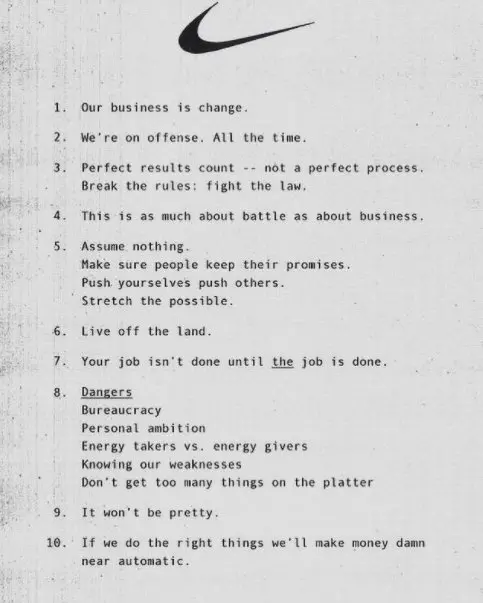Have you been to one of those workshops where they asked you to write a mission statement? I have been to few. It is amazing how writing a mission statement refines your thoughts and provides you clarity. It doesn’t matter whether it is for your business, life, or profession. A decade into the advertising business, you experience this life-altering epiphany. To write a marketing manifesto that aligns with your values. Similar to the one that Tom Cruise wrote in Jerry Maguire. But the difference is that at least this one doesn’t get you fired.
What is a marketing Manifesto? Marketing Manifesto is a document that provides guidance on how you do marketing, from the way you write, to how your brands approach product launches, design, and more.
There is a lot that’s wrong with the advertising business. Depending on what stage of the career you are at, you may view it differently. Like our mission statements, our experiences are also unique. They sometimes alter our path and the way we process information.
A marketing manifesto or philosophy behind how you approach work creates a solid foundation. In 1977, Jobs and Wozniak brought Mike Markkula on board to pen Apple’s Marketing Philosophy. Mike brought the must needed clarity to Apple’s marketing by creating a three-point call to action – Empathy, Focus, and Impute.
Rob Strasser was an attorney on a critical lawsuit between Nike and Onitsuka. Phil Knight, the founder of Nike, was impressed with Rob and appointed him to be in-house legal staff. Rob went on to become the first Chief Marketing Officer of Nike.
Rob was instrumental in sealing the $2 Billion deal with Micheal Jorden in 1984. He also wrote an internal memo, which was simply titled ‘principles.’ Forty years later, the brand has stayed true to the values mentioned in the original note.
Why You Need a Marketing Manifesto?
It is easier to create a marketing manifesto but difficult to live it. If you are not clear on your brand’s purpose, then it is challenging to develop your manifesto. Your philosophy also evolves depending on your leadership, strategy, people, and other factors.
To live up to the manifesto, you have to ensure alignment between marketing function and leadership. Often what you find happening at most organizations is that brand purpose is not clear, and it starts impacting the way the marketing team behaves. Brand purpose underpins your marketing manifesto. The alignment is the sweet spot where your team and the leadership are completely aligned on the brand’s purpose and are focused on customers’ needs.
Marketing manifesto gives every team member clarity on how their respective role aligns to brand purpose. Marketing manifesto is an evolving document and needs to adapt to the changing needs of the brand. Dave Gerhardt, the former Chief Marketing Officer of Drift, created the marketing manifesto for the brand.
While manifesto is an internal document, more brands are now making it publicly available for customers and stakeholders to see the values they represent. Manifesto, by definition, is a ‘public declaration of a policy.’ Dave decided to make the manifesto public considering a lot of people were interested to know how the brand approaches marketing.
How to craft a Marketing Manifesto?
Identify your brand’s purpose
Start with the brand purpose, which is essentially discovering your brand’s why. Your manifesto represents the fabric of your company, so you have to work as a team to identify the core values, goals, and aspirations.
Here are few questions to simplify the process.
- What problem is your brand trying to solve?
- How does your business impact customers’ lives?
- How is your brand making a difference to the world?
- What does the marketing team exist?
- What principles guide your marketing teams’ actions?
Align with your team and customer values
Consider the values and ideals that your team strongly believes in while crafting the marketing manifesto. When Dave Gerhardt sat down with his team to develop the manifesto, they firmly believed that the marketing team should focus on building relationships and not making your prospects fill out more forms.
It’s our shared beliefs and ideals that add up to create a great marketing manifesto. Manifestos should also consider how customers like to be treated. Ultimately all of us want to be treated as human beings and not as another lead in someone’s automation system.
Govern your critical decisions
Brand guidelines govern your brand’s tone of voice and personality. Marketing manifesto acts as a tiebreaker when critical decisions have to made in marketing. It could be something as simple as quality over quantity.
Leo Widrich, the co-founder of Buffer, writes in the company’s manifesto that they don’t want to be a brand, which simply churns out content. They want every single piece of content to be a breakout hit. The manifesto should bring in the much-needed focus and rigor to your marketing team.
The manifesto should also consider your team’s world view. If your team is not aligned with the marketing manifesto, it will be impossible to live it.
Conclusion
In many ways, the brand and marketing manifesto are one and the same. But at times, the brand manifestos don’t govern the actions of your marketing team. For brands that have a strong legacy, it is easy to look into the past and decide whether this is something that your brand will do.
When critical decisions have to be taken, marketing manifestos serve as a point of reference that governs your team’s action. It also helps the team by aligning them carefully with the brand purpose. At times the companies mission statement might not inspire them, considering it is very broad and doesn’t connect back to the work they do. Marketing manifestos also encourage and bring your team members together for a larger goal.

